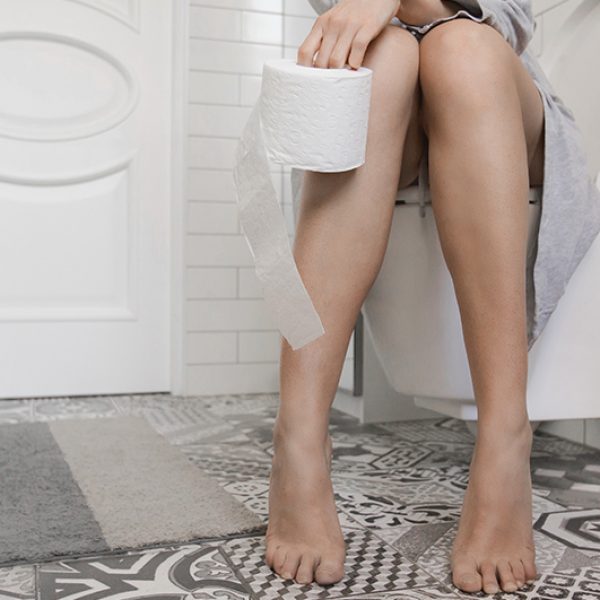

Overcoming Constipation
Constipation can be an embarrassing topic to discuss, but a necessary conversation to have when it comes to your overall health. Constipation is quite common, affecting almost 20% of people every year.[1],[2] Healthy bowel movements are essential to a healthy body but how do you know what’s healthy? Here are some things to keep in mind.
- Stool Colour – Generally, stool should be walnut brown. Temporary colour changes can happen if you eat certain foods such as beets or dark green vegetables.
- Consistency & length– Poop that is passed in one single piece or a few smaller pieces is considered to be a sign of a healthy bowel. Stool should have a consistency similar to toothpaste and the length of a banana.
- Frequency – We should be having at least one good bowel movement per day.
- Gas and odor – Gas is the natural by-product of digestion. However, lots of gas is not normal, nor should it be really stinky.
- Sink or float– Normal healthy stool should leave the body easily, settle in the water and gently submerge. If there is not enough daily fibre in the diet, the stool will quickly sink to the bottom of the toilet. If the stool floats, the likely reason may be too much undigested fat.
- Ease of pooping – Many people take a newspaper or their phone into the bathroom and spend time on the toilet. Healthy bowel movements should only take a few minutes. A healthy bowel movement should be painless and require minimal strain. You should also not need to push hard as this could lead to hemorrhoids.[3]
Factors that lead to constipation:
Unhealthy Eating Habits
A diet too low in fibre and water may contribute to constipation. Fibre increases stool bulk, accelerates colon transit time and water keeps the colon hydrated.[4] Canadian women need 25 grams of fibre per day and men need 38 grams. Most Canadians are only getting about half that much.[5] Coffee does not fix constipation – While caffeine can stimulate muscles that trigger a bowel movement, it is also dehydrating.[6]
Lack of Exercise
Exercise helps to move food through digestive tract more quickly. Aerobic exercise, such as brisk walking, accelerates your heart and breathing rates, and helps to stimulate the natural contractions of intestinal muscles.[7] For many people, regular exercise may improve constipation symptoms as well as overall health. 30 minutes of walking or physical activity five times a week is a great place to start.
Medication
Some medications may cause constipation. Talk to your healthcare practitioner and read medication warnings to determine if your medication might cause constipation.
Changes in Routine
When your normal daily activity is altered the bowel can become constipated (travel, sickness, etc). Try to maintain a regular lifestyle. Consistency with your eating and sleeping patterns can help regulate bowel function.
Not Enough Time
Sometimes, a slight urge to eliminate will be felt, but that urge is ignored as we are “too busy” to act upon it. Over time, this reduces the natural urge to eliminate, and the urges become less frequent. Make sure you set aside time to pass stools comfortably.
Proper Eliminative Positioning
The modern toilet does not position the body properly for elimination. The natural and anatomically correct position for elimination in humans is more of a ‘squatting’ position. Use a step stool or phonebook to position yourself properly while using the toilet. [8]
What can you do about it?
Here are a few tips that can help you avoid constipation.[9]
- Include plenty of high-fibre foods in your diet, including beans and legumes, vegetables, fruits, whole grain cereals and bran.
- Eat fewer processed and refined foods.
- Drink plenty of filtered water and herbal teas.
- Get active with regular exercise.
- Try to manage stress.
- Don’t ignore the urge to poop.
- Try to create a regular schedule for bowel movements and don’t sit on the toilet for ages scrolling through your phone.
Taking a daily probiotic may also help. Probiotics are good bacteria that help support intestinal and gastrointestinal health. These bacteria are rich in diversity, and through research, we know that they play key roles in functions such as improving motility, synthesizing key compounds such as B-vitamins and short chain fatty acids, supporting a good balance of gut flora and supporting our immunity.[10] In fact, digestion, your gut bacteria and the integrity of your gut lining strongly affect your overall health. Good digestive health is essential for many things, including nutrient absorption[11], immune function[12], detoxification[13] and chemical and hormone production.[14]
Renew Life® has many probiotic formulas to choose from. Ask your local health food store employee to help you find the best Ultimate Flora® probiotic formula for you.
And don’t forget fibre! FibreSMART® is a flax-based fibre supplement formulated to help support daily bowel health. Available in both powder and capsule form, it contains both soluble and insoluble fibre and has additional ingredients for the intestinal tract such as Marshmallow Root and Slippery Elm Bark. It is easy to incorporate into your daily routine and contains no nuts, gluten, dairy or soy.
Don’t let constipation be an issue in your life. You can make visits to the bathroom quick and easy with proper diet and lifestyle changes along with supplementation.
References:
[1] Canadian Digestive Health Foundation staff. (2021). Constipation: What to Do If You Can’t Poop. Available: https://cdhf.ca/health-lifestyle/constipation-what-to-do-if-you-cant-poop/. Last accessed 4 Feb 22.
[2] Higgins PD, Johanson JF. Epidemiology of constipation in North America: a systematic review. Am J Gastroenterol. 2004 Apr;99(4):750-9. doi: 10.1111/j.1572-0241.2004.04114.x. PMID: 15089911.
[3]Northrup, C. (2019). How Healthy Is Your Poop? Available: https://www.drnorthrup.com/how-healthy-is-your-poop/. Last accessed 4 Feb 22.
[4] Hwan Bae, S.. (2014). Diets for Constipation. Available: https://www.ncbi.nlm.nih.gov/pmc/articles/PMC4291444/. Last accessed 4 Feb 22.
[5] Government of Canada Staff. (2019). Nutrients in Food: Fibre. Available: https://www.canada.ca/en/health-canada/services/nutrients/fibre.html. Last accessed 4 Feb 22.
[6] Davis, C.P. . (2018). Digestive Disorders: 23 Constipation Myths and Facts. Available: https://www.onhealth.com/content/1/constipation_facts. Last accessed 4 Feb 22.
[7] BadGut.org authors (2019). Constipation Management. Available: https://badgut.org/information-centre/a-z-digestive-topics/constipation/. Last accessed 4 Feb 22.
[8] NDNR Staff. (2007). Proper Positioning For Elimination. Available: https://ndnr.com/anti-aging/proper-positioning-for-elimination/. Last accessed 4 Feb 22.
[9] Mayo Clinic Staff. Constipation Prevention. Available: https://www.mayoclinic.org/diseases-conditions/constipation/symptoms-causes/syc-20354253. Last accessed 4 Feb 22.
[10] ibid.
[11] Krajmalnik-Brown R, Ilhan ZE, Kang DW, DiBaise JK. Effects of gut microbes on nutrient absorption and energy regulation. Nutr Clin Pract. 2012;27(2):201-214. doi:10.1177/0884533611436116
[12] Wu HJ, Wu E. The role of gut microbiota in immune homeostasis and autoimmunity. Gut Microbes. 2012;3(1):4-14. doi:10.4161/gmic.19320
Claus, S., Guillou, H. & Ellero-Simatos, S. The gut microbiota: a major player in the toxicity of environmental pollutants?. npj Biofilms Microbiomes 2, 16003 (2016). https://doi.org/10.1038/npjbiofilms.2016.3
[13] Rosenfeld, C. (2017). Gut Dysbiosis in Animals Due to Environmental Chemical Exposures. Available: https://www.frontiersin.org/articles/10.3389/fcimb.2017.00396/full. Last accessed 4 Feb 22.
[14] Gerard Clarke, Roman M. Stilling, Paul J. Kennedy, Catherine Stanton, John F. Cryan, Timothy G. Dinan, Minireview: Gut Microbiota: The Neglected Endocrine Organ, Molecular Endocrinology, Volume 28, Issue 8, 1 August 2014, Pages 1221–1238, https://doi.org/10.1210/me.2014-1108.

